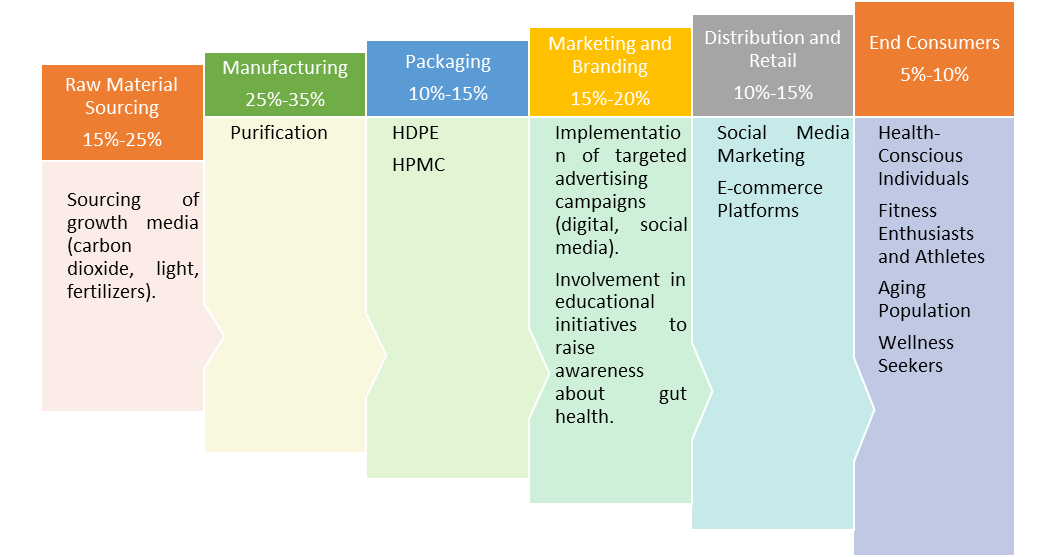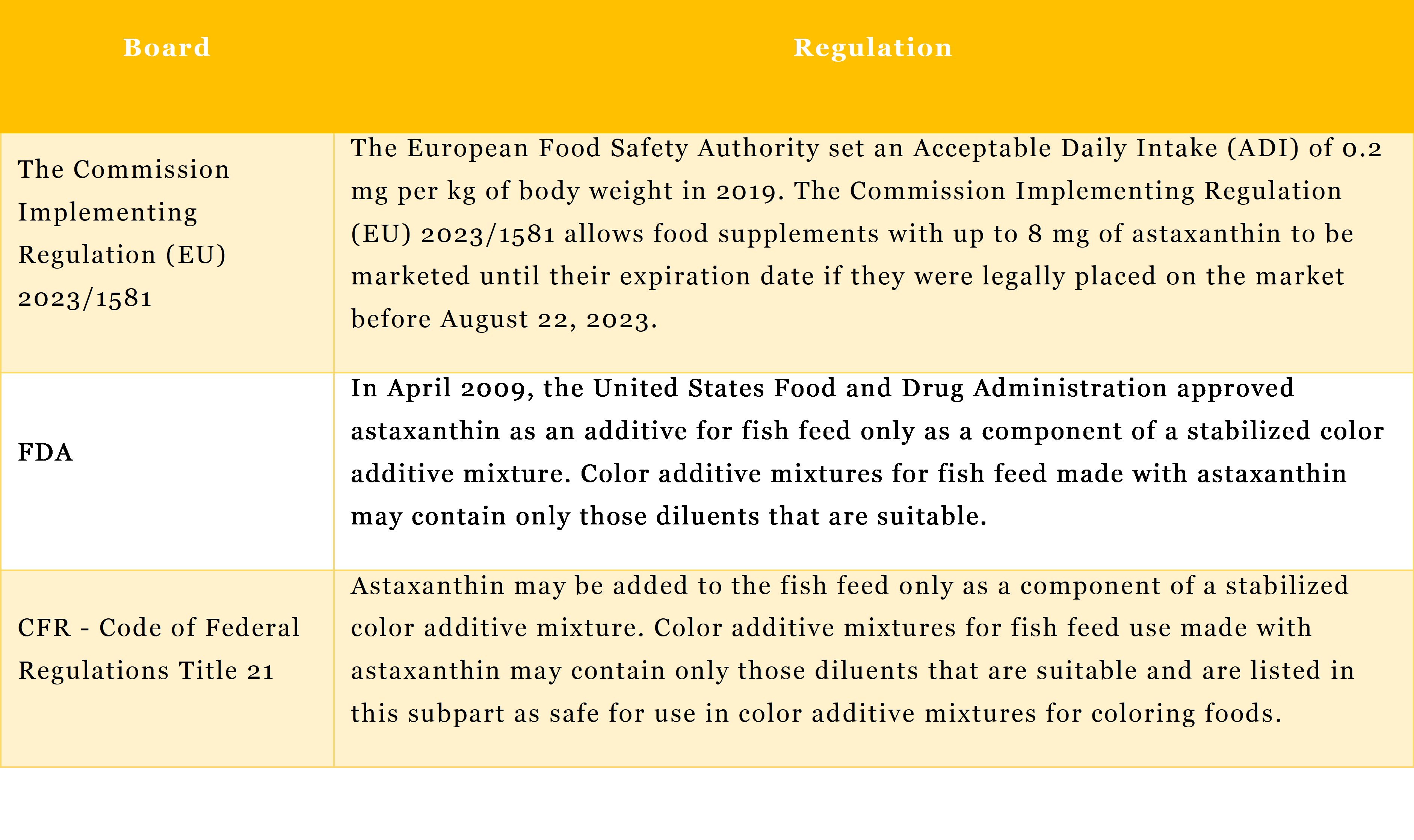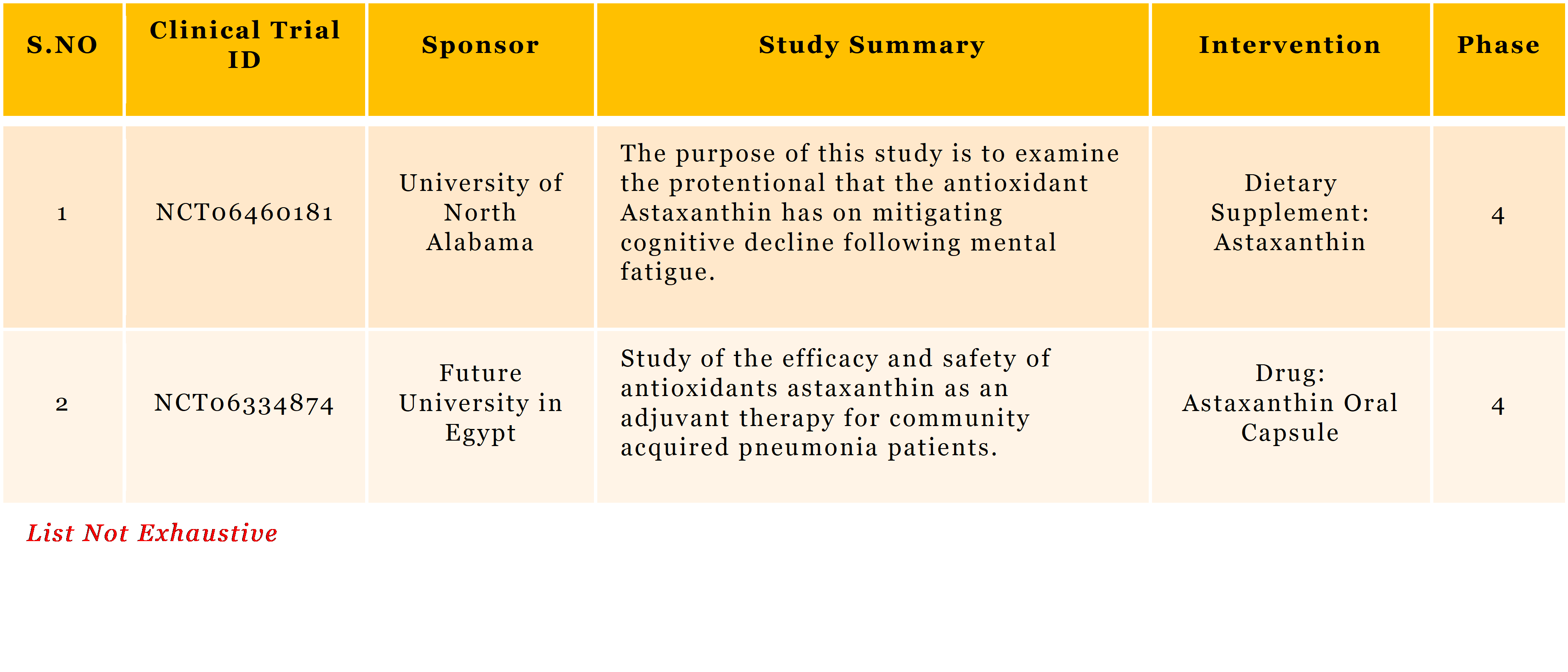Report Overview
Global Natural Astaxanthin Market reached US$ 0.84 billion in 2023 and is expected to reach US$ 1.5 billion by 2031, growing with a CAGR of 7.7% during the forecast period 2024-2031.
The natural astaxanthin market is experiencing significant growth, driven by the rising demand for natural antioxidants across various sectors such as nutraceuticals, cosmetics, food & beverages, and animal feed. Natural astaxanthin, primarily derived from Haematococcus pluvialis microalgae, is renowned for its potent antioxidant properties, offering health benefits such as anti-aging effects, enhanced immune response, improved skin health, and protection against oxidative stress.
This has led to its increasing utilization in dietary supplements and functional foods, particularly among health-conscious consumers and the aging population who seek natural solutions for chronic health conditions and general well-being. The nutraceuticals segment is driving market growth due to the rising demand for natural antioxidants, health-conscious consumer trends, and the expanding applications of astaxanthin in functional foods, dietary supplements, and sports nutrition.
In North America, there's a growing consumer shift towards natural, health-enhancing products, driven by increased awareness of the health benefits of antioxidants. Natural astaxanthin, known for its anti-inflammatory and anti-aging properties, is gaining attention in dietary supplements, functional foods, and beverages. With growing interest in natural health solutions, sustainability, and preventive healthcare, the natural astaxanthin market is poised for robust growth in the coming years, especially in emerging markets where health and wellness trends are gaining traction.
Scope
|
Metrics |
Details |
|
CAGR |
XX% |
|
Size Available for Years |
2022-2031 |
|
Forecast Period |
2024-2031 |
|
Data Availability |
Value (US$) |
|
Segments Covered |
Source, Form, Application, Sales Channel, and Region |
|
Regions Covered |
North America, Europe, Asia-Pacific, South America, and Middle East & Africa |
|
Fastest Growing Region |
North America |
|
Largest Region |
North America |
|
Report Insights Covered |
Competitive Landscape Analysis, Company Profile Analysis, Market Size, Share, Growth, Demand, Recent Developments, Mergers and Acquisitions, New Product Launches, Growth Strategies, Revenue Analysis, Porter’s Analysis, Pricing Analysis, Regulatory Analysis, Supply-Chain Analysis, and Other key Insights. |
Dynamics
Development Strategies Adopted by the Companies
Strategies like partnerships, product launches, and expansions are pivotal in accelerating the growth of the natural astaxanthin market. These strategies help companies tap into new markets, enhance product offerings, and improve production capacities. For instance, in 2024, AgroSystems (“KAS”), a leading microalgal innovation and production company, had raised a $3 million Series A2 funding round led by S2G Ventures. The funding will accelerate the commercialization of KAS’s pioneering method for producing natural astaxanthin from microalgae, a key component in sustainable aquaculture systems as well as a clinically proven human nutraceutical. KAS has patented an innovative process that uses dark fermentation in closed vertical tank systems to produce high-quality natural algae astaxanthin.
Additionally, in 2024, AstaReal, global pioneer in production and research of natural algal astaxanthin, had launched a rebranded version of its finished formulation Astaxin for consumers in Sweden and Norway. In addition to online stores and health food stores, the supplement is also now available in selected pharmacies. Moreover, in 2023, AstaReal had started a new partnership with raw material distributor C.F.M. Co. Farmaceutica Milanese. After the partnership, nutraceutical producers in Italy who wish to include AstaReal natural astaxanthin in their formulations will receive professional technical, regulatory, scientific and logistical support.
Rising Demand for Natural Antioxidants and Sustainable Aquaculture Practices
The natural astaxanthin market is primarily driven by the increasing demand for natural antioxidants in the dietary supplement, cosmetic, and food & beverage industries. The increasing popularity of clean-label and natural ingredients among consumers has led manufacturers to include natural astaxanthin, valued for its powerful antioxidant properties and benefits for eye health, anti-aging, and skin protection. Global Organization for EPA and DHA Omega-3s (GOED) noticed, the dietary supplement sector, where natural astaxanthin is frequently used, saw substantial growth in 2023, with a rising focus on ingredients that support eye health and skin care. The increasing consumer knowledge and desire for ingredients sourced sustainably and environmentally friendly are also strengthening the market.
Another key driver is the rising use of natural astaxanthin in aquaculture, particularly in salmon farming, to enhance the pigmentation and overall health of farmed fish. According to the Food and Agriculture Organization (FAO), Global fisheries and aquaculture production in 2022 surged to 223.2 million tonnes, a 4.4 percent increase from the year 2020. with astaxanthin being a critical component in fish feed due to its coloring and antioxidant benefits. Additionally, the shift towards sustainable aquaculture practices and the reduction of synthetic additives have led to an increased preference for natural alternatives like astaxanthin. This trend aligns with the global movement towards eco-friendly and health-conscious products, further supporting market expansion.
High Production Costs
High production costs are a significant restraining factor for the natural astaxanthin market, affecting the profitability and competitiveness of products derived from this valuable carotenoid. The production of natural astaxanthin primarily involves the cultivation of microalgae, such as Haematococcus pluvialis, which is renowned for its ability to produce astaxanthin in high concentrations. This cultivation requires specific environmental conditions, including optimal light, temperature, and nutrient availability, which can lead to increased operational costs.
For instance, according to National Library of Medicine, 2021, stated that, the high production cost of natural astaxanthin as well as several technological problems (that are common to all microalga derived products) are currently limiting the mass production of this ingredient. For example, the cost of producing natural astaxanthin using the microalga H. pluvialis in the EU is approximately USD$ 1672.88/ Kg.
Sustainability Analysis
The increasing demand for natural astaxanthin in the nutraceutical and aquaculture industries is the main factor driving its sustainable growth. The Global Organization for EPA and DHA Omega-3s (GOED) has noted an increase in consumer demand for natural antioxidants, with a preference for natural astaxanthin over synthetic forms because of its environmentally friendly production process. Companies are putting money into environmentally friendly ways to make things, like growing Haematococcus pluvialis microalgae in controlled environments, which has a lot less of an effect on the environment than making synthetic astaxanthin. As stated by the Algae Biomass Organization, this approach aids in carbon sequestration and reduces water consumption, in line with worldwide sustainability objectives.
Due to consumer demand for natural, traceable components, sustainable sourcing practices are growing in popularity in the food and beverage industry. Industry groups such as NAXA stress that natural astaxanthin producers are more and more utilizing renewable energy and closed-loop systems to improve sustainability. Additionally, the use of non-genetically modified strains in cultivation ensures adherence to organic standards, further boosting its appeal among health-conscious consumers. This sustainable approach not only enhances the product's marketability but also helps companies meet regulatory requirements for eco-labeling, driving market growth..
Regulatory Analysis
Pricing Analysis

Supply Chain Analysis
Value Chain Analysis

Consumer Analysis

Go-To-Market Strategy

Clinical Trial Data
Segment Analysis
The global natural astaxanthin market is segmented based on Source, Form, Application, Sales Channel, and Region.
Market Growth in Nutraceuticals Driven by Astaxanthin Demand and Innovations
The nutraceuticals segment is driving market growth due to the rising demand for natural antioxidants, health-conscious consumer trends, and the expanding applications of astaxanthin in functional foods, dietary supplements, and sports nutrition. Nutraceutical companies are increasingly forming alliances with research institutions and biotechnology firms to improve astaxanthin extraction technologies and develop innovative product formulations.
Additionally, there is a growing trend towards natural, plant-based, and sustainable ingredients in the nutraceuticals market. Natural astaxanthin, derived from sources like microalgae (Haematococcus pluvialis), appeals to consumers who prefer natural alternatives over synthetic antioxidants. With its strong scientific backing and expanding applications across functional foods, supplements, and sports nutrition, natural astaxanthin is poised to play a significant role in the future of the nutraceuticals market.
Geographical Penetration
High Demand for Natural Astaxanthin from North America
In North America, there's a growing consumer shift towards natural, health-enhancing products, driven by increased awareness of the health benefits of antioxidants. Natural astaxanthin, known for its anti-inflammatory and anti-aging properties, is gaining attention in dietary supplements, functional foods, and beverages. For instance, in 2024, the US-based chemical vendor Alfa Chemistry had launched of a series of premium natural astaxanthin ingredients aimed at improving health and well-being. Astaxanthin, a powerful antioxidant with numerous health benefits, is known for its ability to support cardiovascular health, skin health, and eye health, among other things. Additionally, U.S. organic retails sales increased by an average of 8 percent per year. In 2021, organic retail sales were estimated to be more than $52 billion, about 5.5 percent of all retail food sales. U.S. farms and ranches sold nearly $11 billion in organic products in 2021. Imports also are helping to meet consumer demand.
Moreover, North America's relatively favorable regulatory framework for dietary supplements and natural ingredients has also facilitated the growth of the natural astaxanthin market. For instance, astaxanthin from algae, synthetic and bacterial sources is generally recognized as safe in the United States. Additionally, North America has seen a rise in the distribution of natural astaxanthin products across various platforms, including both physical retail chains and e-commerce. Thus, above factors, combined with strong consumer interest in natural, safe, and effective ingredients, continue to drive growth in this region.
Competitive Landscape
The major global players in the market include Algalif, Cyanotech Corporation, AstaReal, Valensa International, Atcama BIO, Algatech LTD, Piveg, Cardax, Inc, Xi'an Healthful Biotechnology Co., Ltd, and Algae Health Sciences.
Market Segmentation
By Source
- Microalgae
- Yeast
- Crustaceans
- Others
By Form
- Powder
- Liquid
- Capsule/Tablets
- Others
By Applications
- Nutraceuticals
- Cosmetics and Personal Care
- Food & Beverages
- Feed
- Pharmaceuticals
- Others
By Sales Channel
- B2B
- B2C
By Region
- North America
- US
- Canada
- Mexico
- Europe
- Germany
- UK
- France
- Italy
- Spain
- Rest of Europe
- South America
- Brazil
- Argentina
- Rest of South America
- Asia-Pacific
- China
- India
- Japan
- Australia
- Rest of Asia-Pacific
- Middle East and Africa
Key Developments
- In May 2024, Divi's Nutraceuticals, an American company, introduced AstaBead, a sustainable astaxanthin beadlet product, at Vitafoods 2024 in Switzerland. AstaBead is created in partnership with Algalif and makes use of Algalif's manufacturing plant in Iceland, running entirely on renewable energy, highlighting a focus on sustainability.
- In April 2024, Alfa Chemistry, a chemical supplier from the United States, launched a new range of high-quality natural astaxanthin ingredients designed to improve health and wellness. This release demonstrates the company's commitment to broadening its product range in the nutraceutical industry.
- In February 2024, AstaReal, a top Swedish company in astaxanthin manufacturing, renamed its Astaxin Original product and unveiled intentions to introduce a vegan option in the European market shortly. AstaReal showcased the renamed product at the Fi Europe event in Frankfurt in late 2023, emphasizing its dedication to creativity and meeting various consumer tastes.
Why Purchase the Report?
- To visualize the global natural astaxanthin market segmentation based on Source, Form, Application, Sales Channel, and Region.
- Identify commercial opportunities by analyzing trends and co-development.
- Excel data sheet with numerous data points at the natural astaxanthin market level for all segments.
- PDF report consists of a comprehensive analysis after exhaustive qualitative interviews and an in-depth study.
- Product mapping available as excel consisting of key products of all the major players.
The global natural astaxanthin market report would provide approximately 70 tables, 66 figures, and 215 pages.
Target Audience 2024
- Manufacturers/ Buyers
- Industry Investors/Investment Bankers
- Research Professionals
- Emerging Companies





